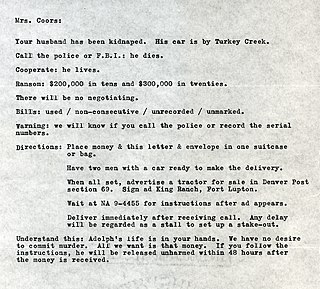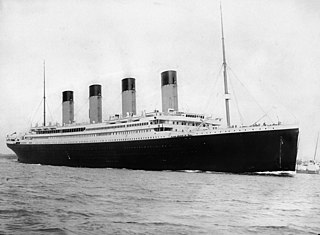
RMS Olympic was a British ocean liner and the lead ship of the White Star Line's trio of Olympic-class liners. Unlike the other ships in the class, Olympic had a career spanning 24 years from 1911 to 1935. This included service as a troopship during the First World War, which gained her the nickname, Old Reliable. She returned to civilian service after the war, and served successfully as an ocean liner throughout the 1920s and into the first half of the 1930s, although increased competition, and the slump in trade during the Great Depression after 1930, made her operation increasingly unprofitable.

The Tower Hill Memorial is a pair of Commonwealth War Graves Commission memorials in Trinity Square Gardens, on Tower Hill in London, England. The memorials, one for the First World War and one for the Second, commemorate civilian merchant sailors and fishermen who were killed as a result of enemy action and have no known grave. The first, the Mercantile Marine War Memorial, was designed by Sir Edwin Lutyens and unveiled in 1928; the second, the Merchant Seamen's Memorial, was designed by Sir Edward Maufe and unveiled in 1955. A third memorial, commemorating merchant sailors who were killed in the 1982 Falklands War, was added to the site in 2005.

Edward John Smith was a British naval officer. He served as master of numerous White Star Line vessels. He was the captain of the RMS Titanic, and perished when the ship sank on its maiden voyage.

Shanghaiing or crimping is the practice of kidnapping people to serve as sailors by coercive techniques such as trickery, intimidation, or violence. Those engaged in this form of kidnapping were known as crimps. The related term press gang refers specifically to impressment practices in Great Britain's Royal Navy.

RMS Mauretania was an ocean liner designed by Leonard Peskett and built by Wigham Richardson and Swan Hunter for the British Cunard Line, launched on the afternoon of 20 September 1906. She was the world's largest ship until the launch of RMS Olympic in 1910. Mauretania became a favourite among her passengers. She captured the eastbound Blue Riband on her maiden return voyage in December 1907, then claimed the westbound Blue Riband for the fastest transatlantic crossing during her 1909 season, which she held both speed records for 20 years.

Charles Herbert Lightoller, was a British mariner and naval officer. He was the second officer on board the RMS Titanic and the most senior member of the crew to survive the Titanic disaster. As the officer in charge of loading passengers into lifeboats on the port side, Lightoller strictly enforced the women and children only protocol, not allowing any male passengers to board the lifeboats unless they were needed as auxiliary seamen. Lightoller served as a commanding officer in the Royal Navy during World War I and was twice decorated for gallantry. During World War II, in retirement, he voluntarily provided his personal yacht and sailed her as one of the "little ships" that played a part in the Dunkirk evacuation.

Crystal Serenity is a cruise ship owned by Crystal Cruises before the line went out business. Crystal Serenity was built in 2003 by STX Europe in St. Nazaire. She operated together with her older fleetmate, Crystal Symphony, offering around the world voyages.

Southampton is a port city in the ceremonial county of Hampshire in southern England. It is located approximately 70 mi (110 km) south-west of London and 15 mi (24 km) west of Portsmouth. The city forms part of the South Hampshire built-up area, which also covers Portsmouth and the towns of Havant, Waterlooville, Eastleigh, Fareham and Gosport.
Pen and Sword Books, also stylised as Pen & Sword, is a British publisher which specialises in printing and distributing books in both hardback and softback on military history, militaria and other niche subjects; factual non-fiction, primarily focused on the United Kingdom (UK). Pen and Sword has over 6,000 titles available in print, and also available as ebook download. Releasing 500 new titles each year on a variety of subjects, it is part of the Barnsley Chronicle newspaper group.
Titanic: The Complete Story is an American documentary chronicling the story of the ocean liner RMS Titanic which sank on its maiden voyage in 1912. It is a compilation of a four-hour documentary special produced by A&E Television Networks in 1994. A&E Home Video originally sold the entire documentary in a 4-tape VHS set. It is considered by many critics and historians to be the definitive documentary regarding the Titanic.

The crew of the RMS Titanic were among the estimated 2,208 people who sailed on the maiden voyage of the second of the White Star Line's Olympic class ocean sea liners, from Southampton, England to New York City in the United States. Halfway through the voyage, the ship struck an iceberg and sank in the early morning of 15 April 1912, resulting in the deaths of over 1,500 people, including approximately 688 crew members.

RMS Titanic was a British passenger liner, operated by the White Star Line, which sank in the North Atlantic Ocean on 15 April 1912 after striking an iceberg during her maiden voyage from Southampton, UK, to New York City. Of the estimated 2,224 passengers and crew aboard, more than 1,500 died, which made the sinking one of the deadliest for a single ship up to that time. It remains the deadliest peacetime sinking of a superliner or cruise ship. The disaster drew public attention, provided foundational material for the disaster film genre, and has inspired many artistic works.
This is a timeline of the world's largest passenger ships based upon internal volume, initially measured by gross register tonnage and later by gross tonnage. This timeline reflects the largest extant passenger ship in the world at any given time. If a given ship was superseded by another, scrapped, or lost at sea, it is then succeeded. Some records for tonnage outlived the ships that set them - notably the SS Great Eastern, and RMS Queen Elizabeth.

The Titanic Engineers' Memorial is a memorial in East (Andrews) Park, Southampton, United Kingdom, to the engineers who died in the Titanic disaster on 15 April 1912. The bronze and granite memorial was originally unveiled by Sir Archibald Denny, president of the Institute of Marine Engineers on 22 April 1914. The event was attended by an estimated 100,000 Southampton residents.

The SeaCity Museum is a museum in Southampton, England, which opened on 10 April 2012 to mark the centenary of RMS Titanic's departure from the city. It is housed within a part of the Grade II* listed civic centre building which previously housed the magistrates' court and police station. The museum contains two permanent exhibitions, one dedicated to Southampton's connection with RMS Titanic, and the other to the city's role as gateway to the world. A third space for temporary exhibitions is housed in a purpose-built pavilion extension to the civic centre. Further phases of development may yet add to the exhibition space.

Memorials and monuments to victims of the sinking of the RMS Titanic exist in a number of places around the world associated with Titanic, notably in Belfast, Liverpool and Southampton in the United Kingdom; Halifax, Nova Scotia in Canada; and New York City and Washington, D.C. in the United States. The largest single contingent of victims came from Southampton, the home of most of the crew, which consequently has the greatest number of memorials. Titanic was built in Belfast, Northern Ireland, and had a "guarantee party" of engineers from shipbuilders Harland and Wolff aboard all of whom were lost in the disaster and are commemorated by a prominent memorial in the city. Other contingents of engineers aboard the ship came from the maritime cities of Liverpool in England and Glasgow in Scotland, which erected their own memorials. Several prominent victims, such as Titanic's captain, were commemorated individually. Elsewhere, in the United States and Australia, public memorials were erected to commemorate all the victims.

The sinking of the RMS Titanic on 15 April 1912 resulted in an inquiry by the British Wreck Commissioner on behalf of the British Board of Trade. The inquiry was overseen by High Court judge Lord Mersey, and was held in London from 2 May to 3 July 1912. The hearings took place mainly at the London Scottish Drill Hall, at 59 Buckingham Gate, London SW1.
The ocean liner RMS Titanic has been extensively portrayed in films, books, memorials and museums.
The following is a timeline of the history of the city of Southampton, Hampshire, England.

Hollybrook Cemetery is a cemetery in Bassett, Southampton, England containing around 53,000 graves as of August 2012 and still open to new burials as of March 2016. It is one of the main cemeteries in Southampton.














